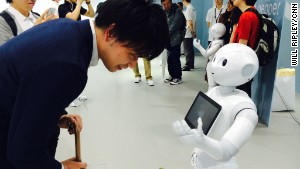BEIJING
(AP) — Students and civil servants in China's Muslim northwest, where
Beijing is enforcing a security crackdown following deadly unrest, have
been ordered to avoid taking part in traditional fasting during the
Islamic holy month of Ramadan.
Statements posted in the past
several days on websites of schools, government agencies and local party
organizations in the Xinjiang region said the ban was aimed at
protecting students' wellbeing and preventing use of schools and
government offices to promote religion. Statements on the websites of
local party organizations said members of the officially atheist ruling
party also should avoid fasting.
"No teacher can participate in
religious activities, instill religious thoughts in students or coerce
students into religious activities," said a statement on the website of
the No. 3 Grade School in Ruoqiang County in Xinjiang.
Similar
bans have been imposed in the past on fasting for Ramadan, which began
at sundown Saturday. But this year is unusually sensitive because
Xinjiang is under tight security following attacks that the government
blames on Muslim extremists with foreign terrorist ties.
Violence
has escalated in recent years in Xinjiang. The ruling party blames
violent extremists that it says want independence, while members of the
region's Uighur ethnic group complain that discrimination and
restrictions on religion, such as a ban on taking children to mosques,
are fueling anger at the ethnic Han Chinese majority.
An attack on
May 22 in the regional capital of Urumqi by four people who threw bombs
in a vegetable market killed 43 people, including the attackers. On
June 22, police in Kashgar in the far west said they killed 13
assailants who drove into a police building and set off explosives,
injuring three officers. Authorities have blamed two other attacks at
train stations in Urumqi and in China's southwest on Muslim extremists.
The
government responded with a crackdown that resulted in more than 380
arrests in one month and public rallies to announce sentences.
The
ruling party is wary of religious activities it worries might serve as a
rallying point for opposition to one-party rule. Controls on worship
are especially sensitive in Xinjiang and in neighboring Tibet, where
religious faith plays a large role in local cultures.
On Tuesday,
authorities in some communities in Xinjiang held celebrations of the
anniversary of the founding of the Communist Party and served food to
test whether Muslim guests were fasting, according to Dilxat Raxit,
spokesman in Germany for the rights group World Uyghur Congress.
"This
will lead to more conflicts if China uses coercive measures to rule and
to challenge Uighur beliefs," said Dilxat Raxit in an email.
The
ruling party says religion and education should be kept separate and
students should not be subject to religious influences. That rule is
rarely enforced for children of Han Chinese, who, if they have a
religion, are mostly Buddhist, Daoist or Christian.
"Students
shall not participate in religious activities; they shall not study
scripts or read poems at script and choir classes; they shall not wear
any religious emblems; and no parent or others can force students to
have religious beliefs or partake in religious activities," said the
statement on the website of the grade school in Ruoqiang County.
A
news portal run by the government of Yili in the northern reaches of
Xinjiang said fasting is detrimental to the physical wellbeing of young
students, who should eat regularly.
In
the city of Bole, retired teachers from the Wutubulage Middle School
were called in to stand guard at mosques and prevent students from
entering, according to a statement on the municipal party committee
website.
Also in Bole, the Bozhou University of Radio and
Television said on its website it held a meeting with working and
retired minority teachers on the first day of the Ramadan to remind them
of the fasting ban.
The forestry bureau in Xinjiang's Zhaosu
county held an event the day before Ramadan at which party cadres signed
a pledge they and their relatives would "firmly resist fasting,"
according to a statement on the website of the local party committee.
The
Moyu Weather Bureau in the Hotan area said on its website that Muslim
employees, both active and retired, were required to sign a letter
promising not to fast.
The commercial bureau for Turpan, an oasis
town in the Taklamakan Desert, said in a statement that civil servants
are "strictly forbidden" to fast or perform the Salat prayer ritual in a
mosque.
original source
:: yahoo












 There are more than a 150 million registered vehicles in India
and the number is only set to rise. With that rise has come a steady
deterioration in the already deplorable safety standards on Indian roads
with people dying every hour in road accidents. However, what really
shocked four engineering students from Bhopal was the number of children
being killed in school-bus accidents. Something needed to be done.
There are more than a 150 million registered vehicles in India
and the number is only set to rise. With that rise has come a steady
deterioration in the already deplorable safety standards on Indian roads
with people dying every hour in road accidents. However, what really
shocked four engineering students from Bhopal was the number of children
being killed in school-bus accidents. Something needed to be done.



























